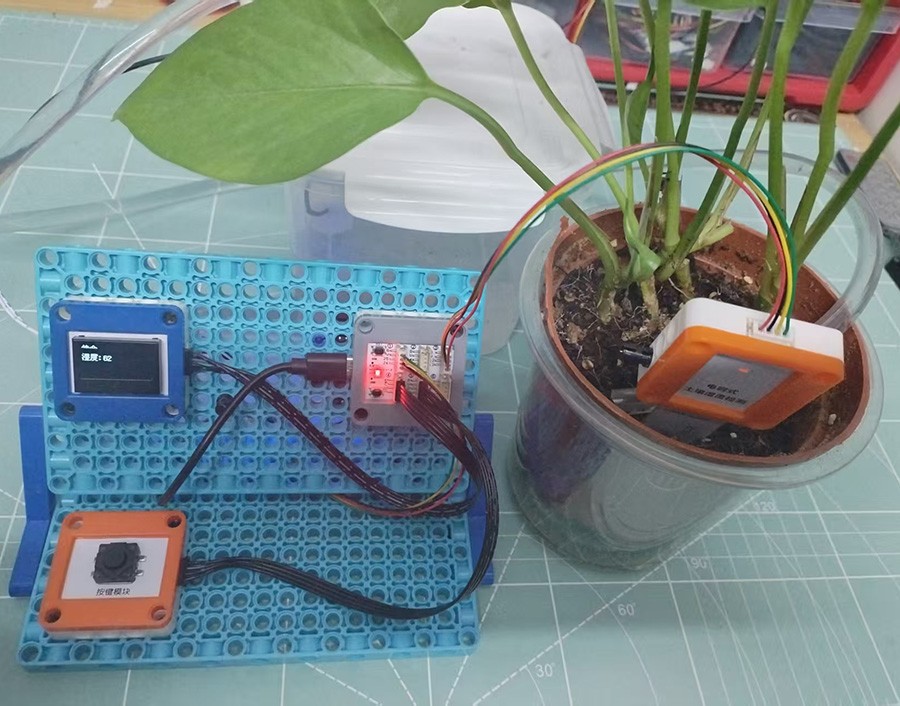12) 口罩篇
前言
上一篇我们把环境和网络问题都解决了,这一篇在 COVID-19 仍在全世界肆虐的当下,我们尝试用 AI 来做一个有趣的自动戴口罩应用。主要用 OpenCV + CNN 来提取面部关键点坐标,再将口罩图片作为蒙版贴合上去。记得国庆中秋双节出门在外,也别忘了戴上口罩保护自己。
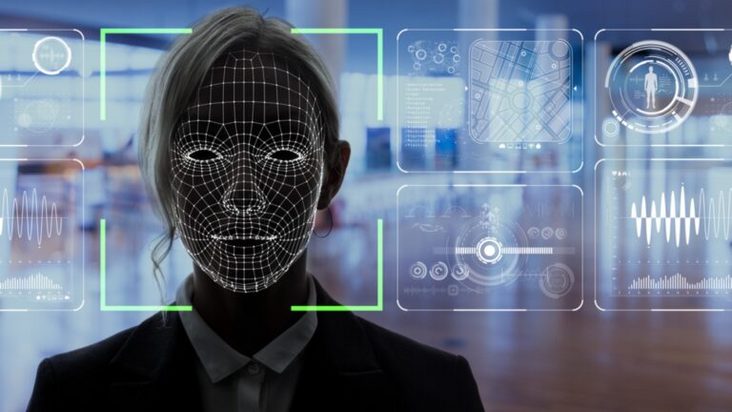
整个戴口罩分为三个阶段:
- 在图像上找到一张脸
- 检测脸上关键点标记
- 用口罩图片来覆盖到口鼻位置
人脸检测
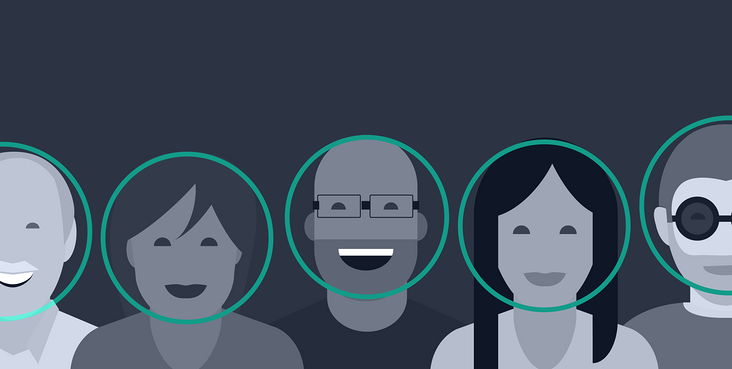
首先,我们要在一张图像上定位脸部的位置,OpenCV 中 DNN 模块就能很轻松的做到。检测模型训练于 Caffe 框架,我们获取一个网络定义文件 face_detector.prototxt 和一个权重文件 face_detector.caffemodel。
# defining prototxt and caffemodel paths
# 人脸检测模型
detector_model = args.detector_model
detector_weights = args.detector_weights
# load model
detector = cv2.dnn.readNetFromCaffe(detector_model, detector_weights)
capture = cv2.VideoCapture(0)
while True:
# capture frame-by-frame
success, frame = capture.read()
# get frame's height and width
height, width = frame.shape[:2] # 640×480
# resize and subtract BGR mean values, since Caffe uses BGR images for input
blob = cv2.dnn.blobFromImage(
frame, scalefactor=1.0, size=(300, 300), mean=(104.0, 177.0, 123.0),
)
# passing blob through the network to detect a face
detector.setInput(blob)
# detector output format:
# [image_id, class, confidence, left, bottom, right, top]
face_detections = detector.forward()
推理之后,我们可以获得人脸序号,类型(人脸),置信度,左,下,右,上坐标值。
# loop over the detections
for i in range(0, face_detections.shape[2]):
# extract confidence
confidence = face_detections[0, 0, i, 2]
# filter detections by confidence greater than the minimum threshold
if confidence > 0.5:
# get coordinates of the bounding box
box = face_detections[0, 0, i, 3:7] * np.array(
[width, height, width, height],
)
我们挑出所有检测到的人脸,过滤掉置信度小于50%的目标,获取到人脸的目标框坐标。
Tip:
人脸检测模型的输入为(300,300),转换图片的时候要注意 Caffe 的输入格式为 BGR 方式。
获取人脸关键点
前面我们已经获得所有人脸的目标框,接下来作为人脸关键点检测模型的输入,就能获得眼睛,眉毛,鼻子,嘴巴,下巴和脸部轮廓等关键点位置。
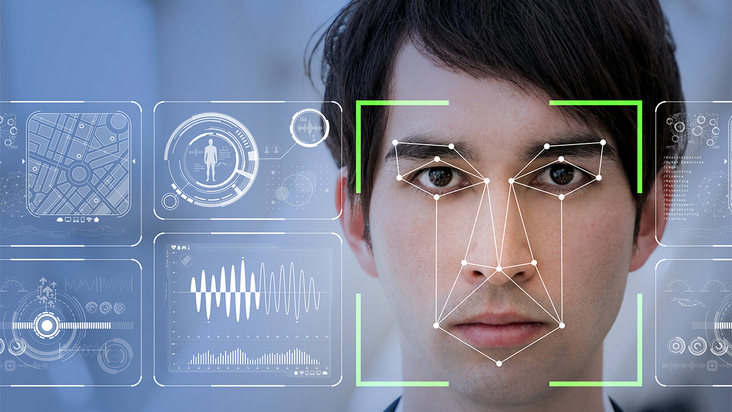
1. 模型概述
这里模型选用的是 HRNet,拥有与众不同的并联结构,可以随时保持高分辨率表征,不只靠从低分辨率表征里,恢复高分辨率表征。中科大和微软亚洲研究院,发布了新的人体姿态估计模型,当年刷新了三项COCO纪录,还中选了CVPR 2019。
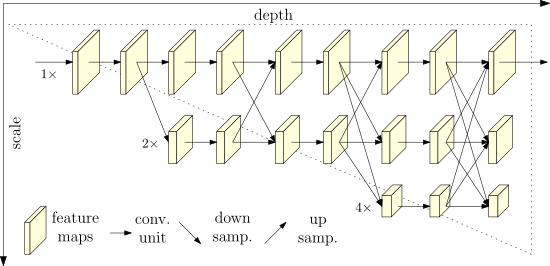
它从一个高分辨率的子网络开始,慢慢加入分辨率由高到低的子网络。特别之处在于,它不是依赖一个单独的、由低到高的上采样 (Upsampling) 步骤,粗暴地把低层、高层表征聚合到一起;而是在整个过程中,不停地融合 (Fusion) 各种不同尺度的表征。
团队用了交换单元 (Exchange Units) ,穿梭在不同的子网络之间:让每一个子网络,都能从其他子网络生产的表征里,获得信息。这样不断进行下去,就能得到丰富的高分辨率表征了。

更多细节,可以参考开源项目
https://github.com/HRNet/HRNet-Facial-Landmark-Detection
2. 裁剪出人脸图片
要注意这里调整脸部尺寸的方式,由于人脸检测模型的输出目标框可能太贴近于脸部,因此我们无法直接采用检测框的精确坐标来裁剪图片。这里采用先把人脸放大1.5倍,再相对于中心位置裁剪出 256 * 256 的图片。
(x1, y1, x2, y2) = box.astype("int")
# crop to detection and resize
resized = crop(
frame,
torch.Tensor([x1 + (x2 - x1) / 2, y1 + (y2 - y1) / 2]),
1.5,
tuple(input_size),
)
3. 预处理HRNet输入图像
转换图像格式,归一化预处理
# convert from BGR to RGB since HRNet expects RGB format resized = cv2.cvtColor(resized, cv2.COLOR_BGR2RGB) img = resized.astype(np.float32) / 255.0 # normalize landmark net input normalized_img = (img - mean) / std
Tip:
要注意 HRNet 的输入图像是 RGB 格式。
4. 模型构建
# init landmark model
# 人脸关键点模型
model = models.get_face_alignment_net(config)
# get input size from the config
input_size = config.MODEL.IMAGE_SIZE
# load model
state_dict = torch.load(args.landmark_model, map_location=device)
# remove `module.` prefix from the pre-trained weights
new_state_dict = OrderedDict()
for key, value in state_dict.items():
name = key[7:]
new_state_dict[name] = value
# load weights without the prefix
model.load_state_dict(new_state_dict)
# run model on device
model = model.to(device)
5. 模型推理
将预处理后的图片输入HRnet 网络,得到68个人脸标记数据,再调用 decode_preds 函数来还原之前对图片的剪裁和缩放,得到原始图片为基准的关键点坐标。
# predict face landmarks
model = model.eval()
with torch.no_grad():
input = torch.Tensor(normalized_img.transpose([2, 0, 1]))
input = input.to(device)
output = model(input.unsqueeze(0))
score_map = output.data.cpu()
preds = decode_preds(
score_map,
[torch.Tensor([x1 + (x2 - x1) / 2, y1 + (y2 - y1) / 2])],
[1.5],
score_map.shape[2:4],
)
口罩图片绑定
现在我们获取到了面部的关键点信息,由于面具一般覆盖于鼻子下方到下巴的上方,因此选用的坐标序号从 2 到 16 这些关键点。
1. 标注口罩图片
为了更好的对齐图片,我们需要对口罩图片进行标注。这里可以采用 makeense,这个开源在线标注工具。简单易用。
https://www.makesense.ai/
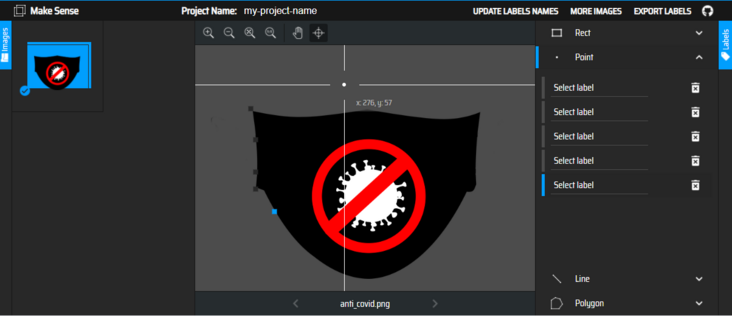
最后将标注保存为 csv 格式。
2. 读取关键点坐标
这里选用关键点 2-16, 30,关键点的起始坐标为0开始。
# get chosen landmarks 2-16, 30 as destination points
# note that landmarks numbering starts from 0
dst_pts = np.array(
[
landmarks[1],
landmarks[2],
landmarks[3],
landmarks[4],
landmarks[5],
landmarks[6],
landmarks[7],
landmarks[8],
landmarks[9],
landmarks[10],
landmarks[11],
landmarks[12],
landmarks[13],
landmarks[14],
landmarks[15],
landmarks[29],
],
dtype="float32",
)
# load mask annotations from csv file to source points
mask_annotation = os.path.splitext(os.path.basename(args.mask_image))[0]
mask_annotation = os.path.join(
os.path.dirname(args.mask_image), mask_annotation + ".csv",
)
with open(mask_annotation) as csv_file:
csv_reader = csv.reader(csv_file, delimiter=",")
src_pts = []
for i, row in enumerate(csv_reader):
# skip head or empty line if it's there
try:
src_pts.append(np.array([float(row[1]), float(row[2])]))
except ValueError:
continue
src_pts = np.array(src_pts, dtype="float32")
3. 绑定关键点坐标
dst_pts 为检测到的人脸坐标;src_pts 为口罩图片标记坐标。
# overlay with a mask only if all landmarks have positive coordinates:
if (landmarks > 0).all():
# load mask image
mask_img = cv2.imread(args.mask_image, cv2.IMREAD_UNCHANGED)
mask_img = mask_img.astype(np.float32)
mask_img = mask_img / 255.0
# get the perspective transformation matrix
M, _ = cv2.findHomography(src_pts, dst_pts)
# transformed masked image
transformed_mask = cv2.warpPerspective(
mask_img,
M,
(result.shape[1], result.shape[0]),
None,
cv2.INTER_LINEAR,
cv2.BORDER_CONSTANT,
)
# mask overlay
alpha_mask = transformed_mask[:, :, 3]
alpha_image = 1.0 - alpha_mask
for c in range(0, 3):
result[:, :, c] = (
alpha_mask * transformed_mask[:, :, c]
+ alpha_image * result[:, :, c]
)
# display the resulting frame
cv2.imshow("image with mask overlay", result)
这里使用 OpenCV 库中的 findHomography 函数查找匹配的关键点之间的变换,然后将所找到的变换矩阵与 warpPerspective 函数一起应用以映射这些点。
获得一个与原始图片 result 大小相同的新图片 transformed_mask,采用 png 格式定义透明通道 alpha_mask,就能将两个图片合并到一起了。
4. 安装依赖
先安装一下 yacs 依赖,用于读取网络结构定义文件。
pip install yacs

5. 在树莓派上跑一下模型
python overlay_with_mask.py --cfg experiments/300w/face_alignment_300w_hrnet_w18.yaml --landmark_model HR18-300W.pth --mask_image masks/anti_covid.png --device cpu
参数说明一下:
cfg:HRNet 的网络配置文件
landmark:HRNet 权重文件
mask_image: 口罩图片
device:推理设备
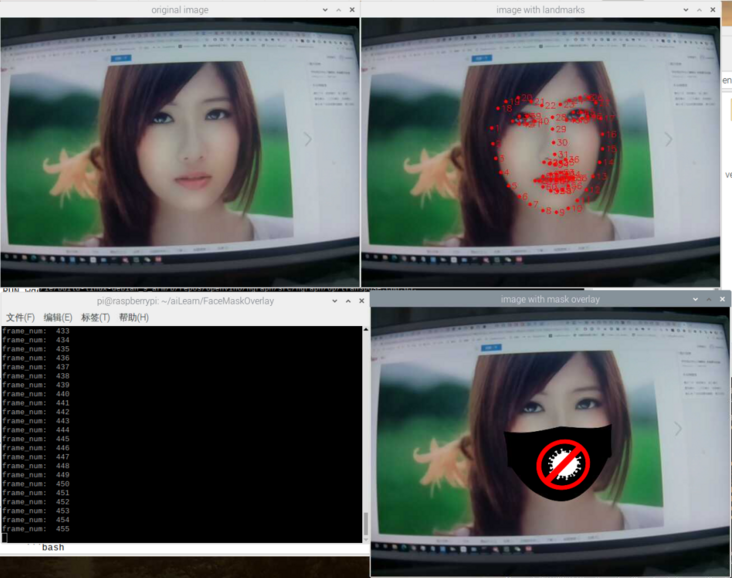
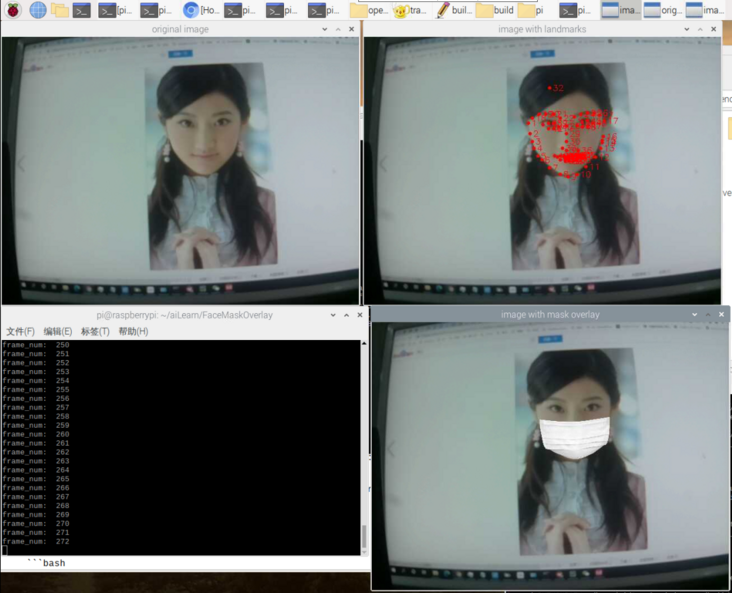
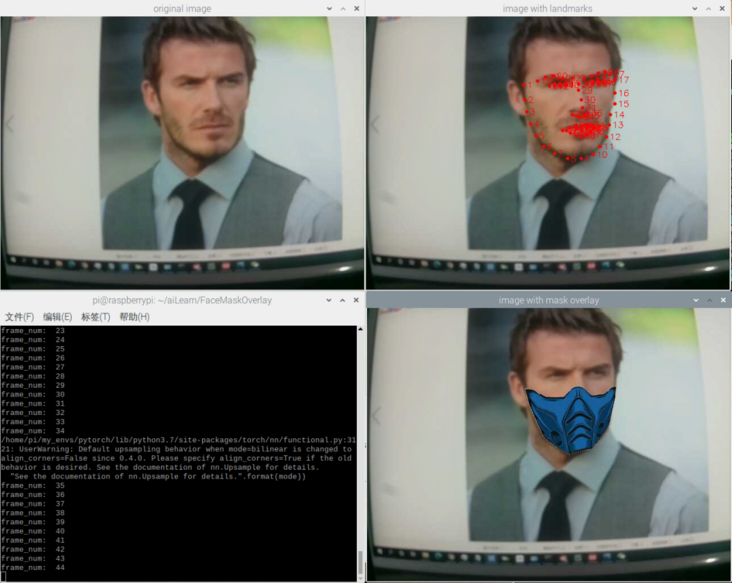
速度比较慢,但还是能正常推理的,说明我们之前的 pytorch 环境都没什么问题。树莓派满负荷状态,要冒烟了。。

Tip:
这里 OpenVINO 有个 bug,主要是32位 OS 的移植性造成的。Replace nGraph's i64 to i32 for size_t,修改nGraph的源码,然后重新编译一下就能解决问题,或者切换到我们之前自己编译的 OpenCV 4.4 的版本。

https://github.com/openvinotoolkit/openvino/issues/1503
6. 用GPU跑一下模型
python overlay_with_mask.py --cfg experiments/300w/face_alignment_300w_hrnet_w18.yaml --landmark_model HR18-300W.pth --mask_image masks/anti_covid.png --device cuda
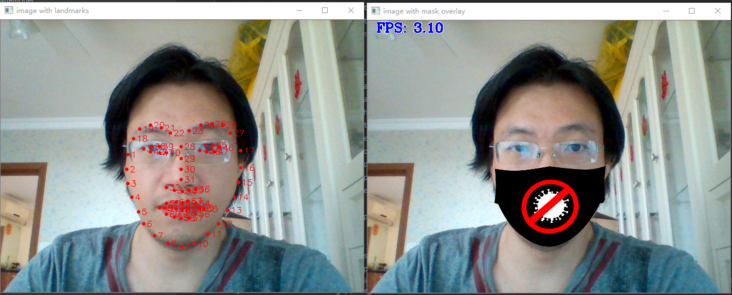
推理速度稍微快了点,笔记本显卡 GTX 1060,基本可以玩玩了。不过里面模型剪裁,读取口罩图片,标注文件 IO 操作也很冗余,两个神经网络也可以分布跑在不同的推理设备上等等,还有很多的优化空间,有兴趣可以进一步提高推理速度。
11) ngrok篇
13) 人脸修复篇
评论:
机器人技术七八级考试说明及知识框架
青少年机器人技术七级、八级着重于机器人智能处理能力的学习,基本编程语言为Python,采用RDK X3作为主控。
手把手教你使用树莓派实现实时人脸检测
本文介绍了如何在树莓派上,使用 OpenCV 和 Python 完成人脸检测项目。该项目不仅描述了识别人脸所需要的具体步骤,同时还提供了很多扩展知识。此外,该项目并不需要读者了解详细的人脸识别理论知识,因此初学者也能轻松跟着步骤实现。
用树莓派4b构建深度学习应用
作者:bluefish 共14讲本教程基于树莓派4B打造一个稳定的软硬件开发环境,再在其上构建AI应用。比如选择构建OpenCV 4.4,pyTorch 1.6和1.7,Tensorflow 2.1,然后在上面跑yolo v5应用,用intel NCS2加速等等…
